The collection of Louise De Hem
The relaunch of Urban Museums in Ypres after WWI
On 19 November, the Yper Museum opens its new temporary exhibition in the Royal Hall of the Cloth Halls. With 'Louise/Edith. Held in high esteem', this exhibition presents the story and oeuvre of Ypres artist Louise De Hem. Contemporary artist Edith Dekyndt acts as Artist in Residence. Louise De Hem's collection is not only one of the largest single-artist collections we manage in Ypres, the collection is also at the origin of today's, urban museums.
Destruction of WWI collection
It is probably no surprise to read that WWI not only left the city in ruins, but also destroyed much of its cultural patrimony. The collection of the Urban Museum, housed on the top floor of the Butchers’ Hall, was also almost completely destroyed. Only the pieces that hung in the Town Hall, including the stationary portraits, survive the violence of war. They are today part of the Yper Museum's collection. The collection of the houses of worship and the Mergehlynck Museum were (partially) saved, however. The Merghelynck collection could be admired from May 1915 in the exhibition of saved art from the Belgian front region in the Salle flamande in the Petit Palais in Paris.[i] After the war, these collections returned to Ypres, often with a diversion.
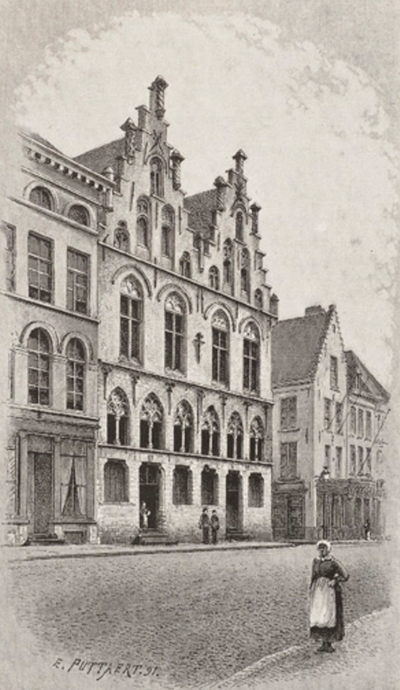
View of the Butchers’s Hall where the Urban Museum was located on the 1st floor until WWI. E. Puttaert (draughtsman) and Jean Malvaux (engraver), Musée et Halle aux viandes, circa 1879 (SM 001551).
The first bequest
After WWI, a new Urban Museum is not a priority for Ypres. The city needs to be rebuilt first. Without a collection, there is nothing to show. Moreover, the Butchers’ Hall, which housed the Urban Museum before WWI, was not rebuilt until 1927. On 14 January 1927, Hélène Ceriez-Dehem dies. She is Louise De Hem's sister and her heir. Louise De Hem's wife, Fréderik Lebbe, had only usufruct over the property. Louise De Hem had been responsible for her sister's maintenance since the death of her brother-in-law Théodore Ceriez. The inheritance should therefore be viewed in this light: by naming her sister as heir, Louise De Hem ensured that her sister would not fall into poverty. Among these possessions are dozens of works and sketches by Louise De Hem.
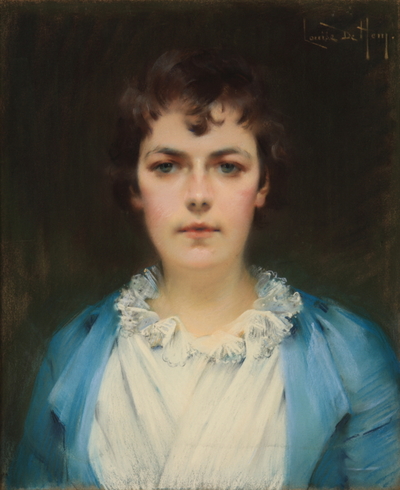
Louise De Hem, Self-portrait, circa 1890. (SM 000309)
When Hélène makes her own will in 1926, she instructs the executor of the will, Florimond Lambin, to find a use for Louise De Hem's artworks. She trusts Lambin to execute her will as she would wish. He gets full control of Louise De Hem's works. In addition, two prizes are to be furnished: prix Louise de Hem and prix Théodore Ceriez. When Hélène dies on 14 January 1927, the will takes effect. Lambin arranges for 49 paintings and pastels by Louise De Hem to go to her native Ypres. He himself keeps a portion. In addition, there is a donation of 10,000 francs to set up a 'Museum Louise De Hem' and an amount of 20,000 francs to set up a prize.
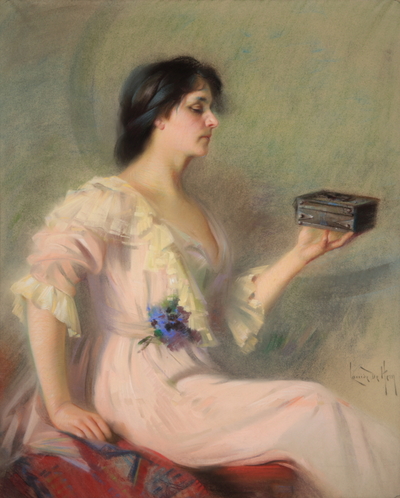
This work was part of the original bequest in 1927. Louise De Hem, Pandora's box, circa 1910. (SM 000550)
The new Urban Museum
28 March 1929, on Maundy Thursday, the rooms Louise de Hem opened in the Butchers’ Hall. This is the first time the Urban Museum has opened since the outbreak of WWI. Museum curator Daniel Tack dares to dream ahead and hopes to open other rooms in the museum soon. Because now, while the museum can show 'modern' works, the historical collection has been destroyed. Building this collection back up will take years, the curator says.[ii]
The curator does not sit still and tries to increase the collection in various ways. For instance, he goes to the royal museums in Brussels in reserves to see if pieces can be shown on loan in Ypres. However, this is not enough because, as he himself points out, the reserves are not inexhaustible and there are other towns that appeal to this after the destruction of WWI.[iii] The proposal in the town council to also house the saved collection of artworks from the C.O.O. (the later OCMW) in the Butchers’ Hall does not seem to find a hearing.[iv] It is only with the opening of the Yper Museum in 2018 that the town's collection and the collection of the houses of worship come together into one.
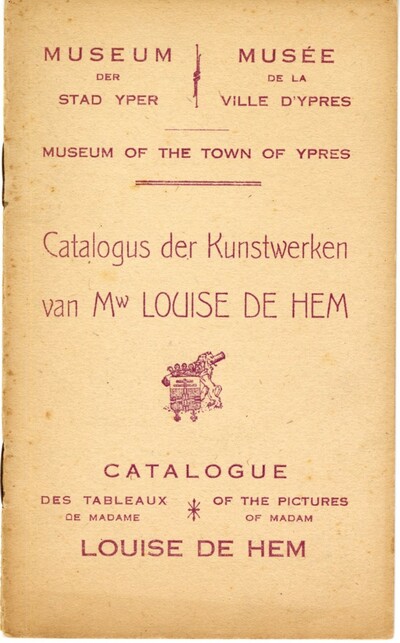
Catalogue released in 1929.
Other funds from the city are also used for the museum. President of the Republic of China Xu Shichang donates the sum of 50,000 Belgian francs to King Albert I in 1919 on behalf of China for the reconstruction of Ypres. The money is meant for the reconstruction of a school and library. For years, the city does nothing with the considerable sum. When the new urban museum opens in 1929, the city decides to use the money for it: porcelain is purchased to decorate a Chinese room,[v] and a new museum is opened.
In addition, the city actively solicits donations of works of art to expand the collection. Newspapers regularly published reports of recent donations to the museum with the names of the generous donors attached, no doubt to encourage other donors. In 1929, for example, donations followed of a stone printing plate of the procession of OLV van Thuyne, a collection of seat medals from the town council between 1848-1884 and a silver coin from 1696.[vi] In 1930, there were also several donations. Among others, old coins, old 'telloors' of Ypres associations, portraits of people's representatives, prints and plans of Ypres are now in the possession of the urban museum. Moreover, at that time, in addition to the two rooms De Hem, a third room was installed in the museum. This room shows portraits of the Belgian royal couple, the king of England and French and English army commanders. There are wall anchors on the stairs in the Butchers’ Hall, rescued from the ruins of Ypres. The portraits are destined for the new war museum, scheduled to open on Garden Day.[vii]
In 1941, Florimond Lambin's bequest brings a further 17 works by Louise De Hem into the possession of Ypres. Among others, "Return of a Procession in Flanders" and "The Country Girl" belong to this second donation. The works only physically came to Ypres after the end of WWII.
The De Hem collection today
Although the collection of the Urban Museum has grown enormously since the initial donation, the De Hem sub-collection continues to occupy an important place in it. Today, the Yper Museum owns 90 works by the Ypres artist. The core of this collection is still the bequest of Hélène Dehem, followed by Florimond Lambin, together accounting for 66 works. The value of the collection can be called unique. It is exceptional within the museum landscape for a museum to hold so many works by a female artist. Moreover, these are the works that Louise De Hem never sold and always kept in her own possession. They include some sketches and preliminary studies, as well as works of great personal value. For instance, several works show her mother and sister as models.
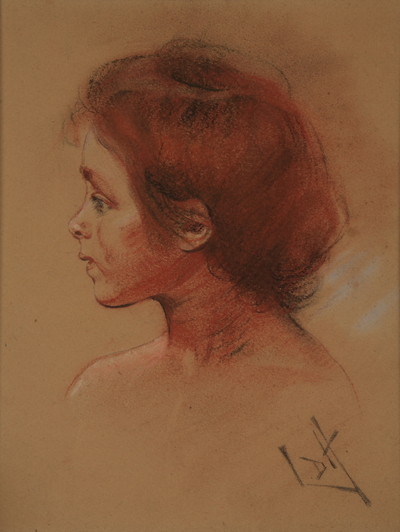
Louise De Hem, Girl in profile - sketch, 1900-1914 (SM 000294g).
This unique provenance of the collection, of course, also creates a bias in the oeuvre. Louise De Hem could not afford to paint for pleasure. With her work, she supported not only herself but also her mother and her sister. She was popular as a portraitist and the majority of her works were undoubtedly commissioned portraits. Only these commissions - naturally - did not remain the property of the artist. Through later donations and purchases, we are in possession of some portraits commissioned by Louise De Hem. Yet the portraits are undoubtedly underrepresented in the Yper Museum's collection.
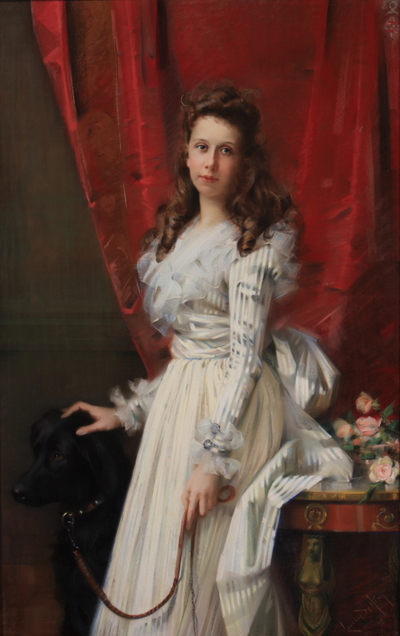
This portrait was donated to the museum by Emma herself in 1954, along with a portrait of her brother Léon. Louise De Hem, Portrait of Emma Osterrieth, pastel, circa 1899 (SM 000543).
Conclusion
100 years after the death of Ypres artist Louise De Hem, the Yper Museum is putting this collection centre stage once again. The importance of this collection for Ypres is manifold. It is not only a unique oeuvre by a female artist around 1900, but also the collection that was at the basis of the new Urban Museum after its destruction in WWI. The 1927 bequest was the starting point for building a new art collection. A collection we can still enjoy today.
LOUISE/EDITH. Held in high esteem from 19 November 2023 to 12 March 2023 in the Royal Hall of the Yper Museum.
[i]D. Dendooven, J. Dewilde and A. Vandenbilcke, Hotel-Museum Arthur Merghelynck.Museum Guide, Ypres, 2001, p. 26.
[ii]Het Ypersche, 30 March 1929, p. 3.
[iii]Het Ypersche, 30 March 1929, p. 3.
[iv]Report in The Ypersche News, 13 April 1929, p. 3.
[v]The Ypersche News, 19 September 1936, p. 3.The Ypersche, 8 December 1928, p. 4. More on this can be found in Sjouwers voor de oorlog : Chinese workers in World War I, exhibition catalogue, Ypres, 2010.
[vi] The Ypersch news, 28 September 1929, p. 2; The Ypersch news, 12 October 1929, p. 3.
[vii] The Ypersche news, 19 April 1930, p. 9. The war museum in question is British Leo Murphy's Ypres Salient War Museum. That museum opened its doors in the cellars of the . the Butchers’ Hall
Scientific contributor Dr Hannelore Franck wrote this article for VIFF magazine.
